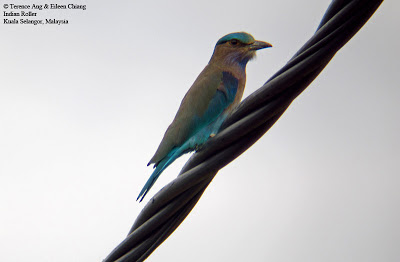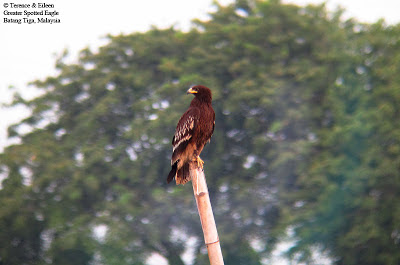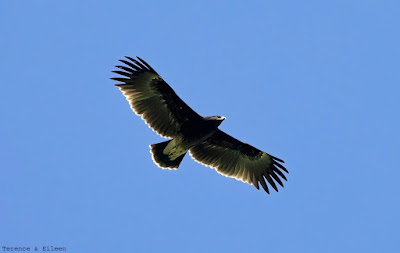Blyth’s Hawk Eagle Spizaetus alboniger (Blyth) 1845
Blyth’s Hawk Eagle Spizaetus alboniger (Blyth) 1845
Other Name: Black and White Hawk Eagle
Resident
Status and distribution
This species is found resident throughout Malaysia.
Description
Adult black and white distinctive. Up right crest distinctive.
Underpart white with black streak on the breast and barred remaining lower part.
Throat white with mesial streak black. Upperpart black sometimes appear dark brownish
black on the wing. broader compare to terminal.
Barring below extend to thigh. Tail is diagnostic to this species
where black terminal, pale subterminal
Some adult show pale white supercilium, which require further
observation and study to see the relationship between age or sexes.
Identification of male and female plumage can be read in the post here.
Inflight wing shape typical of Hawk Eagle and black and white
plumage are distinctive. Wing feather at leas 4 black band.
Juvenile very similar to Wallace’s Hawk Eagle. Mainly brown all
over. See confusion species.
Juvenile (up to first year)
Very similar to Wallace’s Hawk Eagle. Overall rusty brown plumage.
Crest always erect with circular nostril. Throat paler and thighed paler. Faced
and cheeked rusty brown. Underpart of body rusty brown. Crown darker brown compare
to body. Upperpart of body brown with pale tip on feather.
Tail band show only part currently differ from wallaces where
terminal dark band slightly broader then subterminal pale band. Overall roughly
5 tail band can be seen.
Subadult
Heavily moulting on underpart. Tail show marking of adult. Underpart
of body can be seen on thighed and vent and at least some part of the mid body.
Breast streak at this age are still very little.
Moulting four years to adult. However every plumage require further documentation
as this were poorly recorded.
Confusion Species
Highly confuseable depending on age to Wallace’s Hawk Eagle.
Juvenile bird moult begin on thigh <= => wallaces on breast.
Differ greatly on the tail banding in adult. See description above
<= => wallaces evenly devided tail band.
From Indomalayan Honey Buzzard tweedled morph, by crest always erect
<= =>drop floopy in Honey Buzzard. Nostril shape which is circular <=
=> slit in honey buzzard. Position of leg and shape of head provide best
clue to separation.
Geographical Variation
No other was recognize.
Behaviour
Many of this species behaviour are poorly recorded. Hunting are mainly
in perching hunting method. Diet remain poorly recorded with one crow sighted on
nest. Other are small mammals include species such as Low’s Squirrel Himalayan
Stripe Squirrel. Reptile not identified in this country however lizard have
been seen. This was further confirmed through Well’s 1990.
In regards to method use, it was believed to have been based on the habitat
of which hunting in highland and lowland however this require further research.
This however the bird never observed to hunt below canopy compare to Wallace’s
which hunt and track prey below canopy.
Breeding photo and video see the topic of photo and video.
Habitat
In Peninsula Malaysia this species is seem mainly in submontane elevation
however there is occasion where it wander lower such as the Lembah Bujang and Taiping
Lake Garden. See nesting altitude. Seen up to 1,500m asl.
Other lowland forest include foot hill of Maxwell Hill. A lot of
nest were also observed below 500m asl.
Breeding
Nesting poorly documented however recorded year round. Nest in in
few location from Pahang, perak and kedah which has include incubation on
February, August and September. Period observed including February to March,
September to December. Eaglet with juvenile plumage at nest recorded in April,
November and May. Juvenile hatch plumage recorded in March and May.
Tree were estimate at 40 meter high emergent at that location at the
altitude of about 470m asl.
Display behaviour non recorded. Copulating non recorded. Nest
building and incubation period poorly recorded. Both male and female are seen
in the nest. Only once there was a display observed in Perak which describe “One
individual believe to be the male soar at very high altitude. The bird make a
fast and agrresive stoop verticle downwards and lift itself up later to a
perch. Anotehr individual believe to be a female was observed circling and
observing nearby. Time of observation was 11am” There was no nest observed
during this display.
Nesting tree selection usually on slope area and emergent tree. This
with additional criteria of the location required a bare tree nearby of the approximately
same high to the nest where perching bird can oversee the nest. Only one nest
where it was observed both parent actively adding new fresh twig to the nest.
Nest in lower altitude. In sabah Smytheis 1999 Nest was location at
400m. No difference in P. Malaysia where nest were found in the same altitude. However
nest was also found above 1200m asl in Genting Highland and Cameroon Highland.
Dependency period unknown. In all nest only one egg and one eaglet
was raised.
Photo
Nest 1
Nest 2
Video
Nest 1
- Video 1 - Female overlooking nest
- Video 2 - Nestling at nest.
- Video 3 - Female in nest (Day 13-19)
- Video 4 - Female with eaglet (Day 13-19)
- Video 5 - Female near nest (Day 36-42)
- Video 6 - Eaglet
age Day 36-42
- Video 7 - Eaglet
Day 40-46
- Video 8 - Eaglet
Day 41-47 (Special feature)
- Video 9 - Eaglet
feeding with adult (Day 42-48)
- Video 10 - Eaglet
resting after meal (Day 42-48)
- Video 11 - Eaglet
swallowing small mammals (Day 42-48)
- Video 12 - Eaglet at day 45-51
- Video 13 - Adult
near nest
- Video 14 - Eaglet
calling Day 50-56
- Video 15 - Upclose
day 51-57
Reference
Ben F.King & Edwards
C.Dickson, 1989, A Field Guide To The Birds of South-East Asia,
Collins, Grafton Street, London
Craig Robson, 2017, A
Field Guide To The Birds of South-East Asia, Bloomsburry, London
Handbook to Birds of The World,
Lynx Edicions, Bercolona,
Collins, Grafton Street, London
Smythies B.E Revised by Davison
G.W.H, 1999, The Birds Of Borneo,
Natural History Publication, Sabah Malaysia. (ISBN 983-812-028-6)
Susan Myers, 2009, A
Field Guide To The Birds of Borneo, Talisman, Singapore
Boonsong Lekagul & Philip
D.Round, 1991, A guide to the Birds of Thailand, Saha Karn
Bhaet Co., Ltd Bangkok
David R Wells, 1999, Birds
of The Thai Malay Peninsula Vol 1, Academic Press, London UK
James A. Eaton, Bas van Balen,
Nick W. Brickle & Frank E. Rheindt, 2016, Birds of the
Indonesia Archipelago Greater Sundas and Wallacea, Lynx Edicion,
Bercelona
James Fergusan Lee and David A Christie 2001, Raptors of The
World, Christopher Helm, Great Britian (ISBN 0-618-12762-3)
Medway & David R Well 1976, The Birds of the Malay Peninsula
Volume V: Conclusion and Survey of Every Species, Broadwaterpress, England








Comments
Post a Comment